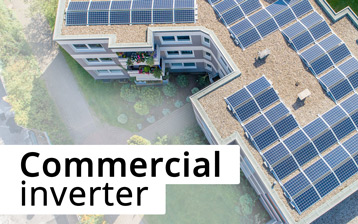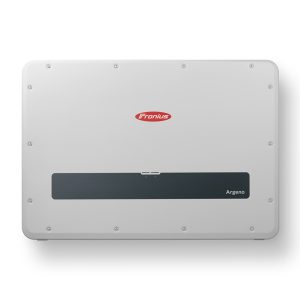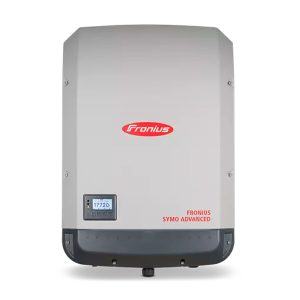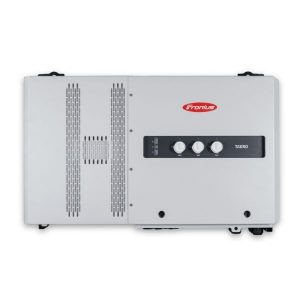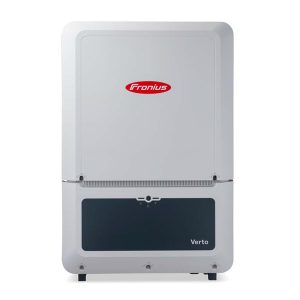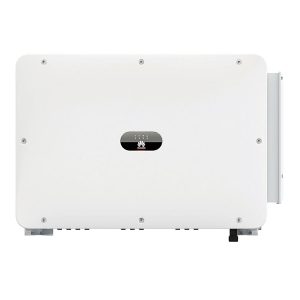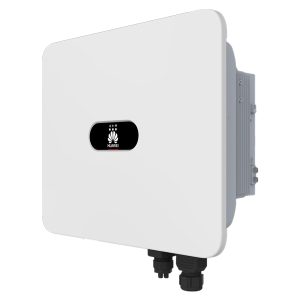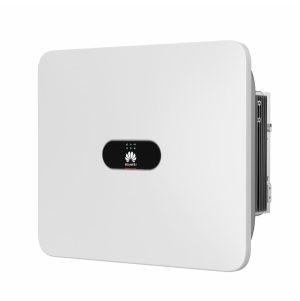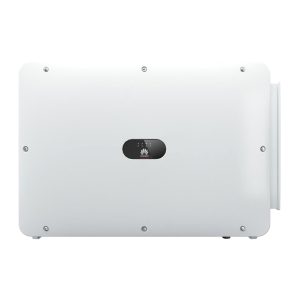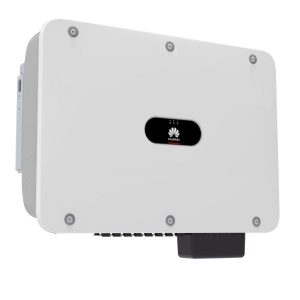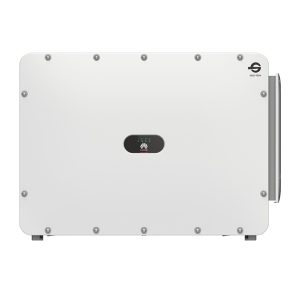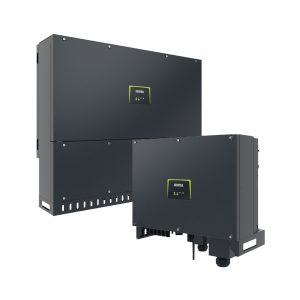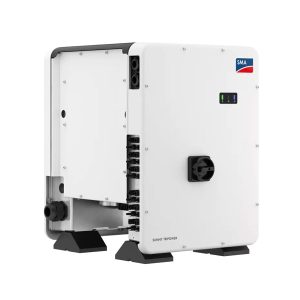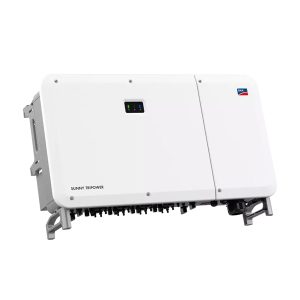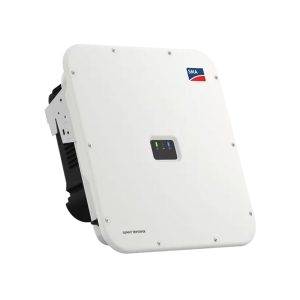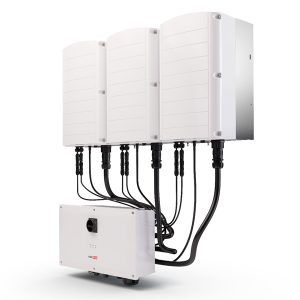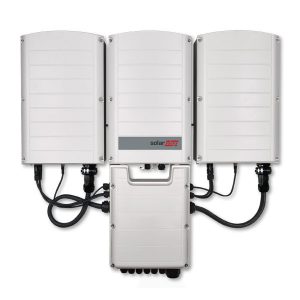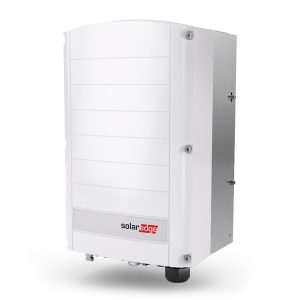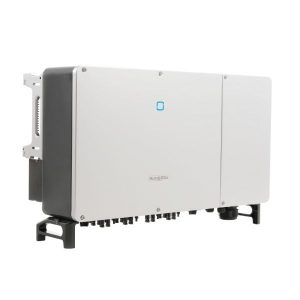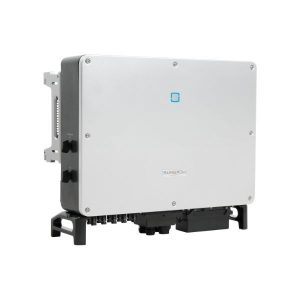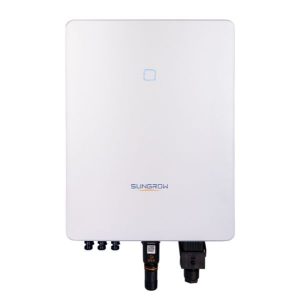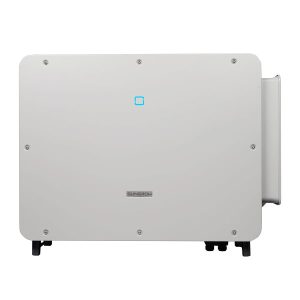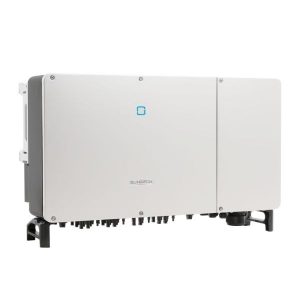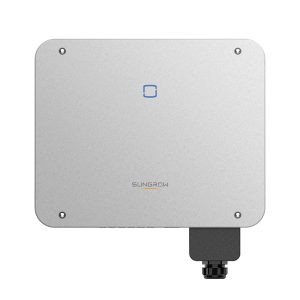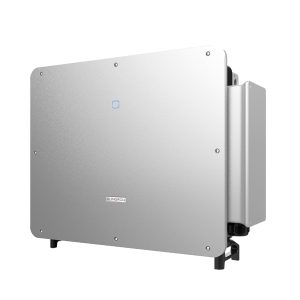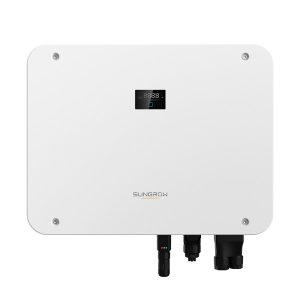The difference between residential and commercial inverters is the size, which defines the range of use of the inverter itself. Commercial inverters are usually defined as inverters with a power greater than 10kW.
Commercial inverters are commonly certified both CEI 0-21 and CEI 0-16, standards that regulate connection to low and medium/high voltage grids respectively.
These products are not limited only to energy conversion, but use technologies to make the system more efficient and long-lasting, some of the technologies used are the following.
MPPT
Through the use of MPPT (Maximum Power Point Tracker) the inverter is able to maximize the energy produced by the photovoltaic modules, this happens because this technology allows each photovoltaic string to work at the maximum power point.
Anti-PID technology
The phenomenon that most influences the performance of photovoltaic modules over time is the PID (Potential Induced Degradation) which is due to the voltage difference that is established between the cells and the frame of the modules.
By now all commercial inverters are equipped with a technology capable of reducing the performance decay of photovoltaic modules, this technology is called Anti-PID.
Arc Fault Circuit Interruption
In commercial inverters the presence of AFCI (arc-fault circuit interrupter) is common, this device is a switch whose role is to interrupt the circuit when it detects the presence of electric arcs, the latter must always be avoided since their presence is a signal of the presence of loose connections in the wiring.
This is one of the most common causes of fires on roofs where there is a photovoltaic system.
Multi-string
Recent inverters have the ability to connect multiple strings of modules to the same MPPT, this allows you to simplify the installation of the system, avoiding the use of junction boxes.
Technical features
Commercial inverters have a power starting from 10/20 kW and generally accept DC input up to 1000V / 1100V, while the number of MPPTs varies from 2 to 10, depending on the inverter power, as regards the output is three-phase at 400V.
These devices are usually also equipped with safety systems such as:
- Reverse polarity protection
- Type I or Type II over-voltage protection
- AFCI
Electrical workshop
Commercial inverters are often used in electrical workshops, also known as power generation workshops.
These are a complex of energy production plants from renewable sources, operated by the same company, with a peak power of more than 20 kW and an energy generation aimed at self-consumption.
This means that any system that draws energy from renewable sources that exceed 20 kW installed for the production of electricity from self-consumption, must report to the Electric Workshop at the Customs Agency office of the competent territory.
Monitoring
In this type of inverter, monitoring plays an important role, as this allows you to detect any anomalies in the system and to intervene promptly to repair the fault.
In large systems, being able to locate the problem allows the installer to save time and consequently make the operation more economical for the end customer.
In large systems often also data loggers are combined with commercial inverters, which allow to verify the production of the inverters connected to them, sometimes with the possibility of adding sensors that allow you to record additional measurement values, for example irradiation and the ambient temperature.
-
Fronius, Inverter, Inverter for commercial and industrial PV systems, Photovoltaic inverter
Fronius Argeno 125.0 – three-phase string inverter
 Fronius, Inverter, Inverter for commercial and industrial PV systems, Photovoltaic inverter
Fronius, Inverter, Inverter for commercial and industrial PV systems, Photovoltaic inverterFronius Argeno 125.0 – three-phase string inverter
The Fronius Argeno 125.0 is a highly efficient three-phase string inverter designed for large commercial and industrial rooftop and ground-mounted photovoltaic systems.
- 10 MPPT (with 2 inputs each)
- Arc fault protection (Fronius Arc Guard)
- Integrated surge protection type 1+2
- Communication via LAN, RS485
- Up to 7 years base warranty (extendable)
SKU: n/a -
Fronius, Inverter, Inverter for commercial and industrial PV systems, Photovoltaic inverter
Fronius Symo Advanced 10.0 / 20.0 – three-phase string inverter
 Fronius, Inverter, Inverter for commercial and industrial PV systems, Photovoltaic inverter
Fronius, Inverter, Inverter for commercial and industrial PV systems, Photovoltaic inverterFronius Symo Advanced 10.0 / 20.0 – three-phase string inverter
The Fronius Symo Advanced is a three-phase inverter ideal for commercial and industrial applications, designed to guarantee reliability, efficiency and maximum safety in every installation.
- 2 MPPT (3 inputs each)
- Fronius Arc Guard (AFCI)
- Integrated DC circuit breaker
- Integrated datamanager: WLAN, Ethernet, 2x RS485, USB
- Warranty: 5 to 10 years (see manufacturer’s website for more details)
Available sizes:
- Standard version: 10.0-3-M, 12.5-3-M, 15.0-3-M, 17.5-3-M, 20.0-3-M
- Light version (without Datamanager): 10.0-3-M Lite, 12.5-3-M Lite, 15.0-3-M Lite, 17.5-3-M Lite, 20.0-3-M Lite
SKU: n/a -
Fronius, Inverter, Inverter for commercial and industrial PV systems, Photovoltaic inverter
Fronius Tauro – 50/100 kW – inverter for C&I
 Fronius, Inverter, Inverter for commercial and industrial PV systems, Photovoltaic inverter
Fronius, Inverter, Inverter for commercial and industrial PV systems, Photovoltaic inverterFronius Tauro – 50/100 kW – inverter for C&I
Fronius Tauro is an inverter useful for any commercial and industrial system, suitable also for outdoor installations in extreme climates.
- Reduced installation costs (BOS)
- Mechanical ventilation for maximum performance even under direct sunlight
- Maintenance can be done on site by a single person
- Available in multiple versions: Standard/ECO, Direct/Precombined
- Available sizes: Tauro 50-3-D, Tauro 50-3-P, Tauro ECO 50-3-D, Tauro ECO 50-3-P, Tauro Eco 100-3-D, Tauro Eco 100-3-P.
SKU: n/a -
Fronius, Inverter, Inverter for commercial and industrial PV systems, Photovoltaic inverter
Fronius Verto – three-phase string inverter
 Fronius, Inverter, Inverter for commercial and industrial PV systems, Photovoltaic inverter
Fronius, Inverter, Inverter for commercial and industrial PV systems, Photovoltaic inverterFronius Verto – three-phase string inverter
The Fronius Verto series is a flexible and safe solution for medium-sized commercial and industrial photovoltaic systems. Available in power classes from 25.0 to 33.3 kW, it is ideal for new installations or the expansion of existing systems.
- 4 MPPTs (with 2 inputs each)
- Integrated arc fault protection (AFCI)
- SPD type 1+2 on AC and DC side
- Integrated DC circuit breaker
- Communication: LAN, WLAN, RS485
- Up to 7 years basic warranty (extendable)
SKU: n/a
-
Commercial inverter Huawei, Huawei, Inverter, Photovoltaic inverter
Huawei SUN2000 100 / 115 KTL – M2 – three-phase
 Commercial inverter Huawei, Huawei, Inverter, Photovoltaic inverter
Commercial inverter Huawei, Huawei, Inverter, Photovoltaic inverterHuawei SUN2000 100 / 115 KTL – M2 – three-phase
Huawei three-phase inverter, ideal solution for commercial and industrial installations.
- 10 MPPT, 20 inputs
- Integrated DC circuit breakers
- IP66
- RS485, MBUS, USB, optional: WiFi, Ethernet, 4G / 3G / 2G
- Available models: 100KTL-M2, 115KTL-M2
SKU: n/a -
Commercial inverter Huawei, Huawei, Huawei, Hybrid inverter, Inverter
Huawei SUN2000 12/15/17/20/25 K-MBO – three-phase hybrid inverter
 Commercial inverter Huawei, Huawei, Huawei, Hybrid inverter, Inverter
Commercial inverter Huawei, Huawei, Huawei, Hybrid inverter, InverterHuawei SUN2000 12/15/17/20/25 K-MBO – three-phase hybrid inverter
Three-phase hybrid SUN2000 12/15/17/20/25 K-MBO inverter ideal for C&I systems, with sizes ranging from 12 to 25 kW
- Efficiency up to 98.2
- Weight and footprint (546 x 460 x 228 mm, weight approx. 21kg)
- IP66 degree of protection
SKU: n/a -
Commercial inverter Huawei, Huawei, Inverter, Photovoltaic inverter
Huawei SUN2000 12/15/17/20/25 KTL-M5 – three-phase
 Commercial inverter Huawei, Huawei, Inverter, Photovoltaic inverter
Commercial inverter Huawei, Huawei, Inverter, Photovoltaic inverterHuawei SUN2000 12/15/17/20/25 KTL-M5 – three-phase
The Huawei SUN2000 M5 three-phase string inverter was created to maximize energy yields in residential and commercial PV systems.
- 2 MPPT (two inputs each)
- RS485, Optional: Ethernet, WiFi, 4G
- IP66 protection rating
- Available sizes: 12/15/17/20/25 KTL-M5
SKU: n/a -
Commercial inverter Huawei, Huawei, Inverter, Photovoltaic inverter
Huawei SUN2000 215 KTL – H0 & H3 – three-phase inverter
 Commercial inverter Huawei, Huawei, Inverter, Photovoltaic inverter
Commercial inverter Huawei, Huawei, Inverter, Photovoltaic inverterHuawei SUN2000 215 KTL – H0 & H3 – three-phase inverter
Three-phase string inverter for utility scale applications.
- Number of MPPTs: 9 (H0) or 3 (H3)
- Maximum input voltage: 1500 V
- AC output voltage: 800 V 3P + PE
- Integrated DC circuit breakers
- IP 66
- RS485, MBUS, USB, optional: WiFi, Ethernet, 4G / 3G / 2G (with SmartLogger 3000A)
- Available models: 215KTL-H0 / 215KTL-H3
SKU: n/a -
Commercial inverter Huawei, Huawei, Inverter, Photovoltaic inverter
Huawei SUN2000 30/36/40/50 KTL-M3
 Commercial inverter Huawei, Huawei, Inverter, Photovoltaic inverter
Commercial inverter Huawei, Huawei, Inverter, Photovoltaic inverterHuawei SUN2000 30/36/40/50 KTL-M3
Commercial Huawei inverter with three-phase output, ideal solution for new installations.
- 4 MPPT, 8 inputs
- Maximum input voltage: 1,100V
- Integrated DC circuit breaker
- Available models: 30 KTL-M3, 36 KTL-M3, 40 KTL-M3, 50 KTL-M3
SKU: n/a -
Commercial inverter Huawei, Huawei, Inverter, Photovoltaic inverter
Huawei SUN2000 330 KTL – H1 – three-phase inverter
 Commercial inverter Huawei, Huawei, Inverter, Photovoltaic inverter
Commercial inverter Huawei, Huawei, Inverter, Photovoltaic inverterHuawei SUN2000 330 KTL – H1 – three-phase inverter
With this three-phase string inverter, Huawei wanted to create the perfect product for large photovoltaic systems.
- 6 MPPTs
- Number of inputs per MPPT: 4/5/5/4/5/5
- AC output voltage: 800 V 3P + PE
- Integrated DC circuit breakers
- IP66
- RS485, MBUS, USB
SKU: n/a
-
Commercial inverter Kostal, Inverter, Kostal, Photovoltaic inverter
Kostal PIKO CI 30/50/60
PIKO CI (Commercial Inverters) series optimized for the needs of large photovoltaic systems.
Greater safety and efficiency, lower additional costs thanks to the integrated Kostal Smart AC Switch which makes external pling switches redundant.- system voltage of up to 1100 V
- DC installation without any string distribution boxes
- Over-assignment of up to 50% (DC to AC) permits flexible generator design
- Available sizes: 50 kW
SKU: n/a
-
Inverter, Inverter for commercial and industrial PV systems, Photovoltaic inverter, SMA
Sunny Tripower Core1 STP 50-41 – inverter di stringa 3PH
 Inverter, Inverter for commercial and industrial PV systems, Photovoltaic inverter, SMA
Inverter, Inverter for commercial and industrial PV systems, Photovoltaic inverter, SMASunny Tripower Core1 STP 50-41 – inverter di stringa 3PH
The Sunny Tripower CORE1 three-phase string inverter represents the world’s first free-standing string inverter solution, ideal for decentralized installations both on roofs and on the ground.
- 6 MPPTs (2 inputs each)
- Free-standing installation
- Integrated DC circuit breaker
- SMA ArcFix (AFCI)
- Communication: Ethernet (2 inputs), WiFi, ModBus, RS485 (optional)
- 5-year warranty (extendable up to 20 years)
SKU: n/a -
Inverter, Inverter for commercial and industrial PV systems, Photovoltaic inverter, SMA
Sunny Tripower Core2 STP 110-60 – 3PH string inverter
 Inverter, Inverter for commercial and industrial PV systems, Photovoltaic inverter, SMA
Inverter, Inverter for commercial and industrial PV systems, Photovoltaic inverter, SMASunny Tripower Core2 STP 110-60 – 3PH string inverter
The Sunny Tripower CORE2 three-phase string inverter is a powerful and flexible solution for large-scale commercial PV systems, both roof and ground mounted. Ideal for decentralized installations in the megawatt range, it combines high performance and safety.
- 12 MPPT (2 inputs each)
- Arc fault circuit interrupter (AFCI)
- DC circuit breaker
- Communication: Ethernet, Modbus and Web interface
- 5-year warranty (extendable up to 20 years)
SKU: n/a -
Inverter, Inverter for commercial and industrial PV systems, Photovoltaic inverter, SMA
Sunny Tripower X 12 / 25 – 3PH string inverter
 Inverter, Inverter for commercial and industrial PV systems, Photovoltaic inverter, SMA
Inverter, Inverter for commercial and industrial PV systems, Photovoltaic inverter, SMASunny Tripower X 12 / 25 – 3PH string inverter
The Sunny Tripower X three-phase inverter features an innovative internal design that enables efficient cooling of the electronic components and ensures maximum durability.
- 3 MPPT (2 inputs each)
- Integrated DC switch
- SMA ArcFix (AFCI)
- Communication: Ethernet (2 inputs), WiFi, ModBus, RS485 (optional)
- 5-year warranty (extendable up to 20 years)
SKU: n/a
-
Inverter, Inverter for commercial and industrial PV systems, Photovoltaic inverter, SolarEdge
SolarEdge commercial three phase Synergy inverter SE50K – SE120K
 Inverter, Inverter for commercial and industrial PV systems, Photovoltaic inverter, SolarEdge
Inverter, Inverter for commercial and industrial PV systems, Photovoltaic inverter, SolarEdgeSolarEdge commercial three phase Synergy inverter SE50K – SE120K
Three-phase inverter for commercial systems with Synergy technology. Composed of multiple separate units that are easy to connect and install thanks to their small weight and size.
- Independent operation of each unit allows for greater uptime and ease of maintenance
- Integrated module-level monitoring
- Automatically reduces DC voltage to touch-safe levels during system shutdown with integrated SafeDC™
- More energy production with up to 150% DC oversizing
- Long-term 12-year warranty, extendable to 20 years
- Available sizes: SE66.6K – SE90K – SE100K
SKU: n/a -
Inverter, Inverter for commercial and industrial PV systems, Photovoltaic inverter, SolarEdge
SolarEdge Three Phase Inverters SE66.6K-SE100K
 Inverter, Inverter for commercial and industrial PV systems, Photovoltaic inverter, SolarEdge
Inverter, Inverter for commercial and industrial PV systems, Photovoltaic inverter, SolarEdgeSolarEdge Three Phase Inverters SE66.6K-SE100K
Three-phase inverter for medium voltage connections with new synergy technology. Designed to work with power optimizers and integrated module-level monitoring.
- Composed of multiple units that can be connected to each other
- Lightness and simplicity of installation
- Integrated Connection Unit with optional integrated DC Safety Switch
SKU: n/a -
Inverter, Inverter for commercial and industrial PV systems, Photovoltaic inverter, SolarEdge
SolarEdge: three phase SE20K – SE33.3K
 Inverter, Inverter for commercial and industrial PV systems, Photovoltaic inverter, SolarEdge
Inverter, Inverter for commercial and industrial PV systems, Photovoltaic inverter, SolarEdgeSolarEdge: three phase SE20K – SE33.3K
SolarEdge three-phase inverters have an efficient conversion architecture for maximum reliability and performance in terms of energy produced.
- designed to work with power optimizers
- Superior efficiency (98.3%)
- Integrated module-level monitoring
- 12-20 year warranty
- Available sizes: SE20K – SE25K – SE30K – SE33.3K
SKU: n/a
-
Commercial inverter Sungrow, Inverter, Photovoltaic inverter, Sungrow
Sungrow SG 110 CX
The Sungrow SG110CX 3-phase inverter is an efficient and reliable solution for commercial and industrial PV systems.
- 9 MPPT (2 inputs each)
- Arc fault circuit interrupter (AFCI)
- Built-in DC circuit breaker
- IP66, C5
- RS485, Optional: WLAN, Ethernet
- 5-year warranty (extendable up to 10 years)
SKU: n/a -
Commercial inverter Sungrow, Inverter, Photovoltaic inverter, Sungrow
Sungrow SG 33/40/50 CX
The three-phase string inverters SG 33-40-50 CX are the most suitable choice for companies that will be able to make the most of their photovoltaic system thanks to a maximum efficiency that reaches 98.7%.
- 3\4\5 MPPT
- IP66 (suitable for outdoors)
- Wi-Fi, Ethernet
- 5-year guarantee
- Available models: SG33CX_V112 / SG40CX_V112 / SG50CX_V112
SKU: n/a -
Commercial inverter Sungrow, Inverter, Photovoltaic inverter, Residential inverter Sungrow, Sungrow
Sungrow SG 5.0/6.0/7.0/8.0/10/12/15/17/20 RT
 Commercial inverter Sungrow, Inverter, Photovoltaic inverter, Residential inverter Sungrow, Sungrow
Commercial inverter Sungrow, Inverter, Photovoltaic inverter, Residential inverter Sungrow, SungrowSungrow SG 5.0/6.0/7.0/8.0/10/12/15/17/20 RT
This range of three-phase string inverters produced by Sungrow is ideal for small and medium-sized residential and commercial systems. These inverters are able to offer high efficiency, without sacrificing smart management, making everything safe and easy to use.
- 2 MPPT
- IP65
- Plug and play connector on the AC side and MC4 on the DC side
- Wlan, Ethernet
- Available sizes: SG5.0RT, SG6.0RT, SG8.0RT, SG10RT, SG12RT, SG15RT, SG17RT, SG20RT.
SKU: n/a -
Commercial inverter Sungrow, Inverter, Photovoltaic inverter, Sungrow
Sungrow SG125CX-P2
SG125CX-P2 is a Multi-MPPT string inverter for 1000 VDC systems, optimizes its solutions for the C&I range with 12 MPPT ensures greater flexibility in system design.
- Up to 12 MPPT
- efficiency 98.5%
- IP66 protection and class C5 anti-corrosion grade
- Dynamic shading optimization mode
- Equipped with AFCI 2.0
- DC input of 30 A per MPPT
- Evo2 DC connection – AC connection OT/DT terminal
SKU: n/a -
-
Commercial inverter Sungrow, Inverter, Photovoltaic inverter, Sungrow
Sungrow SG33/50CX-P2
The SG 33/50 CX-P2 three-phase string inverters combine power and safety with a weight reduction of 34% compared to the previous series.
- 3\4 MPPT with 2 inputs each
- Maximum MPPT current: 30 A
- IP66 protection and C5 corrosion resistance
- Integrated DC circuit breaker
- RS485, Optional: Wi-Fi, Ethernet
- Available sizes: SG50CX-P2
SKU: n/a -
Commercial inverter Sungrow, Inverter, Photovoltaic inverter, Sungrow
Sungrow SG350HX
The Sungrow SG350HX three-phase string inverter is an advanced solution for large-scale PV systems, designed to maximize efficiency and ensure safe and reliable operation.
- 12 MPPT (2 inputs each)
- AC output voltage: 800V
- Type II AC and DC SPD
- IP66
- RS485, PLC
- 5-year warranty (extendable up to 20 years)
SKU: n/a -
Commercial inverter Sungrow, Inverter, Photovoltaic inverter, Sungrow
Sungrow SH 15 / 20 /25 T – three-phase hybrid inverter
 Commercial inverter Sungrow, Inverter, Photovoltaic inverter, Sungrow
Commercial inverter Sungrow, Inverter, Photovoltaic inverter, SungrowSungrow SH 15 / 20 /25 T – three-phase hybrid inverter
The SH-T three-phase hybrid inverter is the most powerful solution among Sungrow’s hybrid inverters and is an excellent solution for commercial and industrial systems that require storage.
- 3 MPPT, 5 DC inputs
- Compatible with Sungrow and BYD high voltage batteries
- IP65
- 10-year warranty
- Communication: RS485, WLAN, Ethernet, CAN
- Available sizes: SH15-T / SH20-T / SH25-T
SKU: n/a





